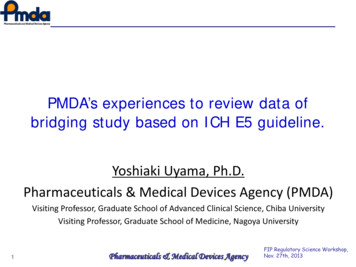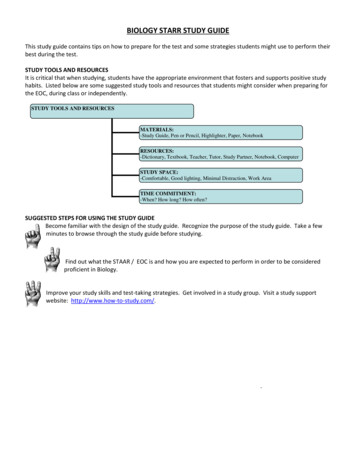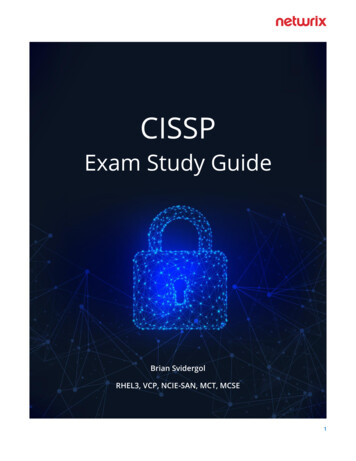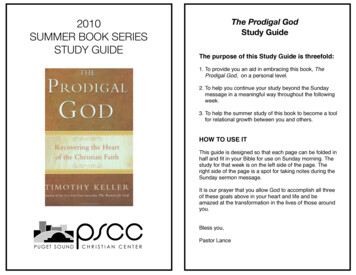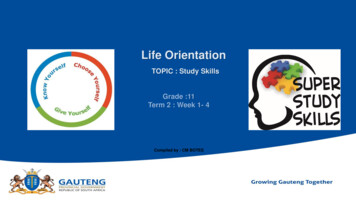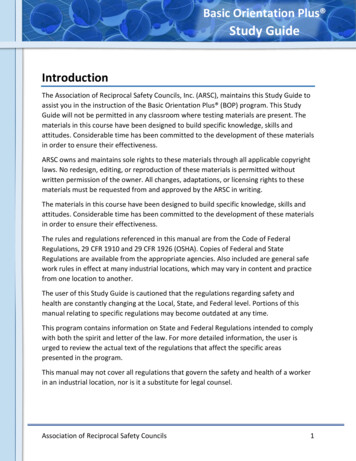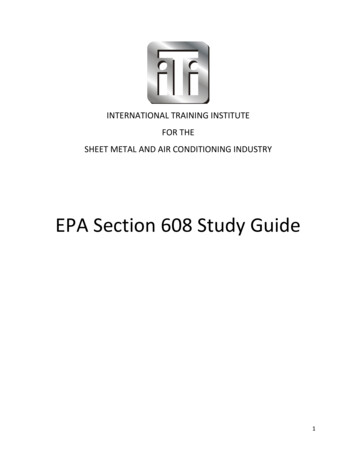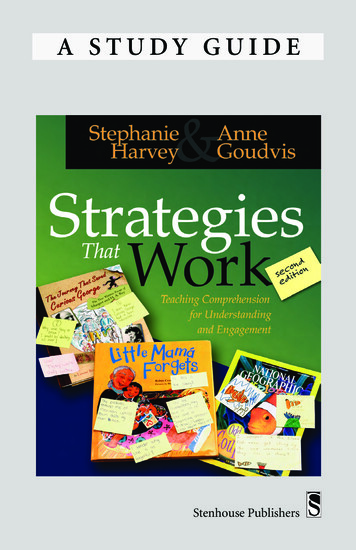
Transcription
A STUDY GUIDEStenhouse Publishers
A STUDY GUIDEStrategies That WorkTeaching Comprehension for Understanding and EngagementSecond EditionStephanie Harvey and Anne GoudvisUsing This Study GuideThis study guide, updated to reflect the new material in the second edition ofStrategies That Work: Teaching Comprehension for Understanding andEngagement, will encourage teachers, librarians, staff developers, and administrators to talk about reading comprehension and student learning and to experiment with new ideas about instruction. Nothing enhances understanding morethan sharing our thinking about teaching and learning, both with our kids andwith each other. This guide presents discussion topics and activities to try out ina formal or informal professional study group and in the classroom. Educatorsare asked to notice their own process as readers and writers and to share thatprocess with others. The study group also provides a forum for bringing kids’ideas and responses to the table for discussion. Students’ thinking informs andextends our teaching more than anything else. If we want our strategy instructionto go beyond a series of mini-lessons, it makes sense to work together to come upwith new and original approaches. The study group offers a great opportunity togo beyond the thoughts and ideas we’ve presented in Strategies That Work andgenerate new thinking. Study groups can be formal or informal, made up of justtwo colleagues or a larger group. This guide can be adapted for a variety of contexts.Introduction to Strategies That WorkReading comprehension is about much more than answering literal questions atthe end of a passage, story, or chapter. Reading comprehension is an ongoingprocess of evolving thinking. When readers read, they carry on an inner conversation with the text. Readers respond with delight, wonder, even outrage. They2Study Guide for Strategies That Work, Second EditionCopyright @2007 by Stephanie Harvey and Anne Goudvis.
question the text, argue with the author, nod their heads in agreement. Theymake connections, ask questions, and draw inferences to better understand andlearn from what they read.The noted children’s author Madeleine L’Engle says, “Readers usually grosslyunderestimate their own importance. If a reader cannot create a book along withthe writer, the book will never come to life. . . . The author and the reader ‘know’each other. They meet in the bridge of words (1995).” We want our students torecognize how important their thinking is when they read. It’s our job as teachersto convince students that their thoughts, ideas, and interpretations matter. Whenreaders engage in the text and listen to their inner conversation, they enhancetheir understanding, build knowledge, and develop insight. Strategies That Workdescribes the inner conversation readers have as they read and the strategies theyuse to understand their reading.Organization and New Material in the SecondEdition of Strategies That WorkThe second edition is divided into four parts: Part I, The Foundation of Meaning, explains how research-based comprehension strategies support and enhance student learning. A new chapter inthe second edition highlights the importance of active literacy instruction toincrease the engagement of students in meaningful work. Part II, Strategy Lessons, describes mini-lessons where teachers and studentsapply the reading strategies, demonstrate response options for using thestrategies, and practice meaningful assessments. New to the second editionare a new chapter, Monitoring Comprehension, which gives additional attention to the inner conversation that good readers must become aware of, andassessment commentaries that accompany new student work samples at theend of each chapter in Part II. These commentaries show how teachers canassess student learning by carefully examining various forms of student reading responses. Part III, Comprehension Across the Curriculum, is brand new. Its chaptersdescribe how to integrate strategy instruction in the content areas and howto help students apply reading strategies to textbook reading and test reading. Part IV, Resources That Support Strategy Instruction, provides an annotated selection of pictures books and other resources for comprehensioninstruction, including bibliographies of magazines and other periodicals andStudy Guide for Strategies That Work, Second EditionCopyright @2007 by Stephanie Harvey and Anne Goudvis.3
websites for students, and professional resources for selecting children’sbooks. These lists of resources have been thoroughly updated for the secondedition.Beginning Your Study with Strategies That WorkThe following questions may be helpful for beginning a conversation aboutStrategies That Work:How do you currently teach comprehension strategies in your classrooms? Are students challenged and excited by their reading? Do they recognize howimportant the reader is to the text? Do students understand and think critically about what they read? Why?Why not? Do students engage with and discuss important issues and ideas in literature?In social studies, science, and other curricular areas? Do you model how to think out loud for students as a means of instruction? Do you give students time to practice using strategies in their own reading?How much time? How are students reading to learn from informational text, including textbooks and other materials? Can students sustain their interest in this information over time?How do you support students to keep track of their thinking when they read? How doyou keep track of their thinking? How do you assess their understanding? In what ways do students recognize and discuss their thinking about reading?Do students hold inner conversations about their reading as well as sharetheir thoughts with others? What evidence do you have that students are understanding and learningfrom their reading? Are there some terms you use to describe how readers think when they read?Should your school use a standardized terminology for comprehensioninstruction? How do your students use written as well as other kinds of responses to showtheir evolving thinking?What resources do you have/need to support comprehension instruction? Do you have the necessary resources for comprehension instruction? Plenty4Study Guide for Strategies That Work, Second EditionCopyright @2007 by Stephanie Harvey and Anne Goudvis.
of books, sticky notes, clipboards, and so on? What are some ways to getthese into your classrooms without breaking the bank? Do you teach with a wide variety of genres? Do you introduce and use a variety of text forms, including short stories,poetry, essays, feature articles, and so on?How do you create a learning community that promotes thinking in your classrooms/schools? Do students feel free to share their ideas, opinions, and tastes in reading?Take stock of the times when you and your students share your thinkingabout books (i.e., read-alouds, discussions, informal sharing times, and soon) and remember to build in time daily to talk about reading. What implications do time, scheduling and room arrangements have foryour instruction? What changes to scheduling, room arrangement, or procedures might be needed to ensure an environment that promotes thinking? Do you have an ongoing reader’s workshop in your classroom? Effectivestrategy instruction requires that students have long blocks or time for reading and responding. How do you support students in their comprehension of content-area textbooks? How do you help students prepare for the reading they’re required to do onstandardized tests?Chapter Descriptions and Study Group Actionsand ConsiderationsPart I: The Foundation of MeaningChapter 1Reading Is ThinkingChapter 2Reading Is StrategicChapter 1 explains how readers make meaning when they read and why it’simportant to teach comprehension. The chapter summarizes strategies that proficient readers use and suggests that if we want readers to use them independently, teachers need to show students how we think when we read. Chapter 2 goesStudy Guide for Strategies That Work, Second EditionCopyright @2007 by Stephanie Harvey and Anne Goudvis.5
into greater detail about what it means to read strategically.Actions and Considerations Start a collection of intriguing articles, short stories, excerpts, poems, orother short pieces. Copy and share these pieces in the study group and decideon one to read together, with each participant keeping track of their innerconversation with the text. Margin notes and coding the text help you recordyour thinking to later share those strategies you used to make sense of thepiece. Consider:What strategies proved useful for understanding this text? What did youdo as a proficient reader to understand new information, ideas, orinsights? Notice your questions, ideas, opinions, or interpretations andshare these. What does paying attention to your own thinking duringreading teach you about supporting students as they learn to use comprehension strategies?Save one of these pieces to share with your students as a model of your ongoing writing/thinking in response to reading. Try a similar activity with your students. Choose an interesting or provocative piece of short text. Provide each student with a copy, read it together, andask students to record their inner conversation on the text or on sticky notes.Then ask students to share their thoughts with a partner. The greatest way toenhance understanding is to talk about the text after reading it. Observe a colleague as he or she launches comprehension strategy instruction. Record the language used to model and explain the strategy. Based onthe students’ responses to the lesson, discuss the effectiveness of the languageand overall lesson. Four levels of metacognitive awareness and the ways in which readers monitor their thinking about their reading are described in Strategies That Work:Tacit readers. Tacit readers lack awareness of how they think when theyread.Aware readers. Aware readers may realize when meaning has brokendown, but lack strategies to fix the problem or repair confusion.Strategic readers. Strategic readers use a variety of strategies to enhanceunderstanding and monitor and repair meaning when it is disrupted.Reflective readers. Reflective readers can apply strategies flexibly depending on their goals for reading. They reflect on their thinking and revisetheir use of strategies. You can observe this reflective stance when students comment with surprise, amazement, or wonder as they read.6Study Guide for Strategies That Work, Second EditionCopyright @2007 by Stephanie Harvey and Anne Goudvis.
Think about two or three students you work with and try to categorize theirlevel of metacognitive knowledge and awareness. Observe and keep track ofhow each student monitors his or her thinking during reading. Consider theways you support students to move through this continuum to become morestrategic and reflective readers. Collect student work—sticky notes, response journal entries, texts with margin notes—and discuss it. What evidence is there that students are keepingtrack of meaning as they read? Can you observe their evolving thinking?Brainstorm some additional ways that students might keep track of theirthinking. Explore each of the strategies defined on pages 16-19 in Strategies That Workin greater depth. Study group participants might work together to add tothese definitions. Consider a common language for reading comprehensioninstruction across ages and grade levels.Chapter 3Effective Comprehension Instruction: Teaching, Tone, andAssessmentChapter 3 describes some of the factors in building effective comprehensioninstruction, including the gradual release of responsibility model, creating anatmosphere for inquiry, collaboration, and authentic responses to reading, therole strategy instruction plays in a workshop classroom, and teaching comprehension with the end in mind by using authentic, meaningful assessment.Actions and Considerations Consider how the gradual release of responsibility approach may help youdifferentiate instruction. How might you provide additional support to smallgroups who need further explanation and practice? How would you provideopportunities for independent work for students who have a clear understanding of a strategy? Document the assessments you use to find out if readers are understandingwhat they read. Do you listen to kids? Confer? Observe behaviors and expressions? What do you do with the information you glean from these assessments? Share your thoughts on these assessments with others in your studygroup. How could you better use the the assessments to improve instruction? Discuss ways that you set the tone for a literate community in your classroom. Set a goal of focusing on one of the following and then discuss howyou worked toward the goal: foster passion and creativity; place value on collaborative learning and thinking; provide extended reading and writing time;Study Guide for Strategies That Work, Second EditionCopyright @2007 by Stephanie Harvey and Anne Goudvis.7
use language in respectful way; give opportunities for authentic responses bystudents; arrange your room to facilitate a literate community; keepresources accessible.Chapter 4Tools for Active Literacy: The Nuts and Bolts ofComprehension InstructionChapter 4 focuses on teaching the reading strategies, explicit comprehensioninstruction, and supporting active literacy by asking students to be participants inthe instruction and to respond to what they’ve read in a variety of ways.Actions and Considerations Consider the balance of teacher work to student work in your classroom.How much time do your students spend being actively, independentlyengaged in investigations, research, discussions, writing, and reading compared with the amount of time you spend instructing? Consider your own instructional practices. Which of these do you use on aregular basis with your students?thinking aloud and coding the textreading aloudinteractively guiding discussionslifting textreasoning through the textproviding anchor experiencesrereading for deeper meaningsharing your own literacy by modeling with adult textWhat other instructional practices do you find particularly effective inengaging and highlighting kids’ thinking? Kids differ. Some kids are able to grasp how to use a strategy quickly, othersneed more time for practice. How do you differentiate strategy instruction toaccommodate a wide variety of learners? Describe how you meet individualneeds through whole-group instruction, flexible small groups, and conferring with individuals. As a group, read the same piece of text and experiment with a variety ofresponse options (see pages 52–58). Talk about your inner conversation anddiscuss the different strategies that come into play with these differentoptions. How does sharing your thinking about your responses enhance yourunderstanding of the text?8Study Guide for Strategies That Work, Second EditionCopyright @2007 by Stephanie Harvey and Anne Goudvis.
Chapter 5Text Matters: Choice Makes a DifferenceChapter 5 describes the importance of selecting compelling and relevant text in avariety of genres to support students in understanding content and to encourageenthusiasm for reading in general. Chapter 5 suggests criteria for choosing text,including picture books, magazines, newspapers, and Web reading.Actions and Considerations Choose several compelling pieces of short text (one page max) that you thinkwould interest your kids. You can select a poem, a story, a feature article, andso on. Introduce each piece and sell the kids on the text to fire them up tostart reading. Students can choose the piece that most interests them, read it,grab a partner who’s read the same text, and start talking. Ask each of themto share their inner conversations. Wander around the room and listen in ontheir discussion, taking notes of what they say. Once in a while, ask them toshare their thoughts with the whole class. Bring your notes to the studygroup and talk about their comprehension process. What impact did the students’ choice of text—or the fact that they had a choice—have on theirengagement with reading and discussions? Start a collection of picture books for teaching different comprehensionstrategies. See Appendix A for lots of book recommendations. Think aboutchildren’s literature you already have in your classroom that would be helpfulin teaching particular strategies. Share these ideas with the study group. As you read the picture books, jot down your responses on sticky notes or ina response journal, focusing especially on how a given strategy or strategieshelped to enhance your understanding of the book. With a partner, brainstorm how you might use one of the instructional approaches described inChapter 4 with one of the books (thinking aloud and coding the text, liftingthe text, reasoning through the text, and so on). Some schools keep lists ofselected books for strategy instruction in the library so teachers can quicklyaccess them. (One school attaches short lesson suggestions to each book in a“strategy text set” located on a shelf just for teachers and the librarian to usein mini-lessons.) The study group might design some lessons for specificbooks they’ve chosen. Discuss the idea that particular titles should not be pegged to teaching a particular reading strategy. What are the advantages and drawbacks of identifying certain texts as “good for teaching questioning,” “good for inferring,” andso on? To begin a text set, think about a topic you or your students are passionate orcurious about. Or think about how you might breathe new life into a timeworn (but well-loved) topic by searching for poems, essays, or new picturebooks related to it. Begin with text you know and love. Remember to includestudent contributions—picture books, short stories, articles, poems, newspaStudy Guide for Strategies That Work, Second EditionCopyright @2007 by Stephanie Harvey and Anne Goudvis.9
per excerpts, essays, and so on. Don’t forget to think about audience, purpose, and quality of writing as you make your selections.Part II: Strategy LessonsChapters 6 through 11 are the nuts and bolts of Strategies That Work. These chapters include lessons organized by comprehension strategy. The lessons move fromless to more sophisticated—the initial lessons are introductory, those that followbuild on the foundation of the earlier lessons. There are twenty new lessons in thesecond edition of Strategies That Work.Chapter 6Monitoring Comprehension: The Inner ConversationThis chapter, new to the second edition, brings focus to the importance ofbecoming aware of thinking as one reads. Students need to tune in to their innerconversations as they read in order to build understanding. It’s important thatstudents become comfortable monitoring their comprehension so they can learnhow and when to apply specific strategies to aid their understanding and learningfrom reading.Actions and Considerations Bring some challenging text to the study group. Read it individually andmonitor how you deal with difficulties while reading. Discuss the fix-upstrategies that each of you uses. Are there certain kinds of fix-ups that workbest for you for certain kinds of challenging text? Discuss what you learnabout your own reading process. Practice a read, write, and talk session in the study group. Observe and discuss what you glean about the value of talking about your reading throughthis experience.Chapter 7Activating and Connecting to Background Knowledge: ABridge from the New to the KnownReaders naturally bring their prior knowledge and experience to reading, but theycomprehend better when they think about the connections they make betweenthe text, their lives, and the world at large. Readers also make other kinds of connections: to literary elements and features, to different genres, to differentauthors, and so on.Actions and Considerations Experiment with different ways of asking kids to keep track of their own connections: a class chart, sticky notes, a response journal, and so on. Keepingtrack of your thinking allows you, as well as your students, to look back and10Study Guide for Strategies That Work, Second EditionCopyright @2007 by Stephanie Harvey and Anne Goudvis.
examine your thought process over time. You might ask: Are students’ connections becoming more meaningful over time? That is, are the connectionsfurthering their understanding of the text, issue, or topic? Do students makea variety of content connections (text to self, text to text, text to world)? Dostudents connect to literary elements and features as well as to the content?Do students’ responses illustrate new and original ways of thinking abouttheir reading? Gather samples of students’ reading responses. Examine the samples in yourstudy group, assessing if and how students’ connections are leading to agreater understanding of what they read. Consider ways to nudge childrenfurther during conferences, just as Steph did in her conference with Allisonon page 104. Teachers often ask about connections kids make that just don’t seem toenhance textual understanding, those “connections in common” and tangential connections discussed on pages 102 to 104 that come fast and frequently.It is your responsibility to check with kids about how their connections helpthem better understand the text. A form that is helpful is the two-columnform headed My Connection/How It Helps Me Understand. Bring a piece oftext to your study group and try this form with your own reading. This formis also helpful for questioning and inferring.Chapter 8 Questioning: The Strategy That Propels Readers ForwardQuestioning is the strategy that keeps readers engaged. When readers ask questions, they clarify understanding and forge ahead to make meaning.Actions and Considerations Once your students have had practice asking questions with lots of differentkinds of texts, try brainstorming questions with them about a puzzling pieceof text, as Anne did with Langston Hughes’ poem “Dreams” on page 119.After you have charted the kids’ questions, encourage their independence byasking each student to respond in writing to a question of their own choosing. As a class, come back together to share these responses, discussing howeach person’s thinking contributes to an understanding of the text. Sharethese responses with the study group. Keep track of the questions you ask for a day or two and bring a list of theseto your study group. Track the kinds of questions you found yourself asking,sorting these into authentic question vs. assessment question categories.Discuss situations and circumstances that encourage each of these kinds ofquestions. As students begin a new topic study in social studies or science, keep a largechart with their questions. Periodically review this chart to sort throughanswers to the questions and to assess if the kinds of questions children askStudy Guide for Strategies That Work, Second EditionCopyright @2007 by Stephanie Harvey and Anne Goudvis.11
are changing. Next to the questions, you might keep a list of “Ways ourschema is changing as we learn more about .”Chapter 9Visualizing and Inferring: Making What’s Implicit ExplicitInferring is at the intersection of taking what is known by garnering clues fromthe text and thinking ahead to make a judgment to discern a theme or speculateabout what is to come. Visualizing strengthens our inferential thinking. When wevisualize, we are in fact inferring, but with mental images rather than words andthoughts.Actions and Considerations The bravest among you can invite a small group of students from your classto share their thinking with the study group. Model your thinking on eithervisualizing or inferring and then involve the students in guided practice onthat strategy. Study group participants can script the various conversationsbetween the teacher and kids and the kids with each other. After the demonstration is complete, study group members can question the kids about theirthinking and learning. Allow time to debrief this lesson after the kids depart.Discuss how this observation can help you plan your own instruction. Don’thesitate to try this technique with any of the strategies discussed in the book. When readers ask a question, an inference is never far behind. Human beingsare driven to answer questions and most often do so with an inference. Apowerful scaffold to link questioning and inferring is the two-column IWonder/I Think form. Try this in the study group with a piece of text thatlends itself to a wide range of interpretations, such as a contemporary poem,and then talk about how your questions and inferences help you understandit. Visualizing expands the possibilities for response beyond talking and writing. The artist in every kid needs opportunities to respond through drawingas well. Choose a piece of text that spurs strong images and try to sketch aresponse that you visualize. If you are feeling particularly adventurous, youcould dramatize a response or sing a song!Chapter 10 Determining Importance in Text: The NonfictionConnectionThoughtful readers grasp essential ideas and important information when reading. Readers must differentiate between less important information and key ideasthat are central to the meaning of the text.Actions and Considerations Using nonfiction texts and excerpts, begin your own class chart of features12Study Guide for Strategies That Work, Second EditionCopyright @2007 by Stephanie Harvey and Anne Goudvis.
that help your students navigate dense text. Bring these charts to your studygroup and examine ways to develop a common language across grade levelsfor teaching these conventions and features. Consider ways that different features help students determine important information. We are big fans of the Facts/Questions/Response (F/Q/R) form. Using thesuggestions described in the Chapter 10 lessons, try several of the two- andthree-column note forms with students. Share student work samples andexamine how these forms scaffold student learning. For instance, do someforms lead to further questioning and research topics? As your students become more adept at strategic reading and thinking,encourage them to apply the strategy for determining importance to theiruse of other strategies. For instance, as kids learn about connections andquestions, they may make lots of tangential ones. Encourage them to look atwhich connections and/or questions are the most important and help thembetter understand what they read. A connection that the reader makes maybe important to him or her but less important to a deeper understanding ofthe text. A good response form for this might be titled Connections, withcolumns below headed: Important to Me, Important to Understanding theText, and Both. In this way you honor all of the readers’ connections but helpthem decide which ones are truly important to understanding. A similarform for questioning has also proved useful. You want to teach your studentsto evaluate the importance of their questions and connections in relation tounderstanding the text. Try this in your own reading with your study group.Chapter 11 Summarizing and Synthesizing Information: TheEvolution of ThoughtSummarizing something we read involves pulling out the important informationand putting it into our own words so we can remember it. Synthesizing involvescombining new information with existing knowledge to form an original idea orinterpretation. Synthesizing lies on a continuum. Rudimentary synthesizinginvolves merely stopping and thinking about what we are reading. Taking stock ofmeaning and reading for the gist is a step further down that line. Sometimes readers have a true synthesis, an “Aha” of sorts where they achieve new insight andchange their thinking. This is the ultimate form of synthesis.Actions and Considerations Bring the texts kids are reading to the study group. Look at their sticky notestogether and notice their evolving thinking. Do they seem to be getting thegist? Does their thinking change as they read? Their sticky notes provide youwith a wealth of information and warrant close examination. Take a look atthe assessment commentaries at the end of each strategy chapter in the second edition of Strategies That Work as models for the kinds of assessmentStudy Guide for Strategies That Work, Second EditionCopyright @2007 by Stephanie Harvey and Anne Goudvis.13
you can do simply by examining your kids’ notes. How does summarizing differ from synthesizing? Summarizing is one aspectof synthesizing. Summarizing is recording events, information, and ideas in afew sentences. Synthesizing is a more sophisticated process that involvesoriginal thinking. Ask students to summarize their thinking and jot downnew thoughts or ideas that occur to them as they read. For instance, a twocolumn form headed Getting the Gist/My New Thinking can prove useful.You might try this response option with your reading in the study group aswell. Synthesizing is the strategy that allows readers to change their thinking ifthey are willing. Because of their age, young readers are actually better atrevising their thinking than adults. It is difficult for adults to read editorialsthey don’t agree with. Sometimes we notice that an op-ed writer with whomwe rarely agree says something that actually hits the mark. The tendency,however, is to skip right over it rather than take it seriously and revise ourthinking. Kids are far less set in their ways and more willing to allow readingto change thinking. Bring in some articles or editorials. Read a variety in thestudy group and see if you can break through your existing paradigm and usereading to change your thinking. Talk about this process with your colleaguesand then share this
Strategic readers.Strategic readers use a variety of strategies to enhance understanding and monitor and repair meaning when it is disrupted. Reflective readers. Reflective readers can apply strategies flexibly depend-ing on their goals for reading. They reflect on their thinking and revise their use of strategies.
